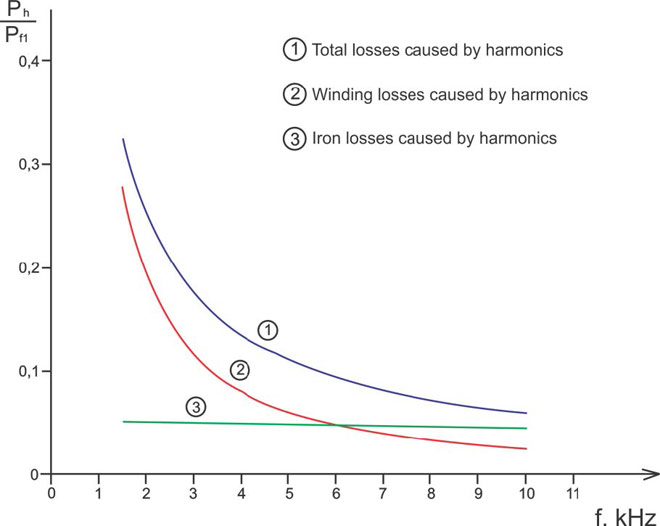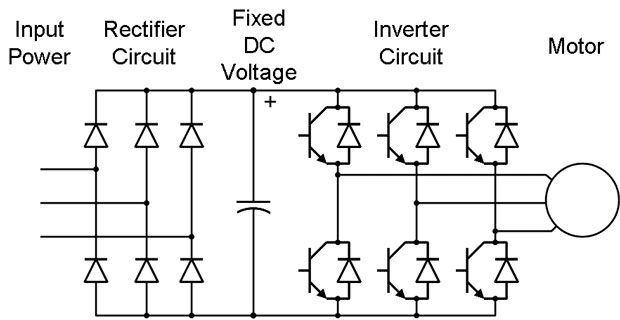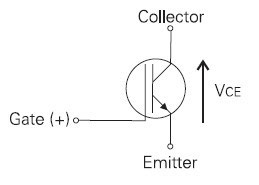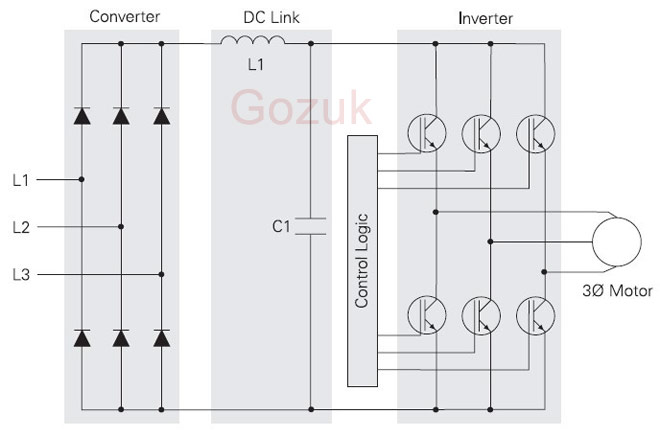VFD and Radio Frequency Interference (RFI)
It is generally believed that VFDs are the ideal technology providing maximum power savings, reduced motors cost and lower maintenance costs. VFDs have tradeoffs that need to be recognized and understood. These tradeoffs (potential drawbacks) include greater harmonic distortion, radio frequency interference and other idiosyncrasies that can make typically used VFDs unfriendly.
All modern VFDs use power devices known as IGBTs. These devices make it possible to minimize annoying audible noise by using switching frequencies beyond the audible range. Unfortunately, VFDs using IGBTs, present a high potential for generating RFI - Radio Frequency Interference.
VFDs can produce sufficient amounts of Radio Frequency noise (RFI) that affect the operation of equipment susceptible to Radio Frequency noise. This is particularly true in older buildings when grounding is lacking or otherwise inadequate.
One example of a substantial RFI problem is a brick apartment complex, built in the mid 20's, where the elevator contractor was in the process of modernizing existing AC elevator equipment. After the first cars were modernized (new controllers included RFI filtering devices), the building superintendent complained that he was unable to listen to his favorite radio station because of interference from the elevators. He stated that the vintage AC elevator controls caused no problems; however, the state-of-the-art static VFDs generated disruptive RFI.
The building manager, considering the complaint unfounded, suggested that the superintendent select a different radio station. The superintendent reported the incident to the FCC. Subsequently, the contractor received an FCC notice to immediately respond and resolve the problem.
At the building the complaint was verified using an inexpensive AC plug in radio and the superintendent's portable battery operated radio equipped with all the latest technology. In the elevator machine room the AC radio was tuned to the AM band and, as expected, there was a considerable amount of interference. At roof level the battery operated radio, tuned to the same frequencies, performed slightly better; however, a considerable amount of interference was evidenced.
In an apartment on the fourth floor, located in the middle of the building, both radios demonstrated a similar level of interference. Conditions were found to be the same in an apartment on the first floor. Outside, in the courtyard which is surrounded by many buildings, AM band station signals were very strong and free of interference.
Simply stepping back inside at the first floor entrance the interference returned. Using the battery operated radio, as the elevator ran one could hear interference during both acceleration and deceleration.
The conclusion, later confirmed by the VFD manufacturer, was that the building, without a solid earth ground, was acting as an antenna. Grounding of the elevator VFD system and motor was occurring through water pipes and whatever other steel may have been present in this brick building.
The VFD manufacturer did additional research to identify some probable causes. The contractor needed to provide a proper earth ground, ground the controller and the motor to this proper earth ground, and use insulated bushings to isolate other devices from the controller and motor to prevent grounding to or through the water piping system. These recommendations are, generally, requirements of the National Electrical Code, but they are sometimes overlooked. An additional suggestion would have been to try an isolation transformer. The VFD manufacturer subsequently confirmed the transformer may not have helped in absence of a proper earth ground.
This is one example of how RF noise pollution can unintentionally be propagated throughout a building. Improper grounding conditions make this possible. Nonetheless, grounding alone may not be the cause of some RFI problems. Certain incorrect installation and wiring practices can also create serious RFI problems.
Reducing Electrical Noise
Variable frequency drive electrical noise, whether it is conducted or radiated, can create unusual phenomenon that are difficult to evaluate. To avoid the effects of electrical noise pollution, consider:
The phenomenon of VFD noise generation can adversely effect many devices including the VFD itself. Nonetheless, VFD offer technology that, in numerous circumstances, can provide more benefits than alternative drives. Awareness of the circumstances that allow VFDs to interfere with other devices and proper design considerations will greatly reduce the effects of these phenomenon.
All modern VFDs use power devices known as IGBTs. These devices make it possible to minimize annoying audible noise by using switching frequencies beyond the audible range. Unfortunately, VFDs using IGBTs, present a high potential for generating RFI - Radio Frequency Interference.
VFDs can produce sufficient amounts of Radio Frequency noise (RFI) that affect the operation of equipment susceptible to Radio Frequency noise. This is particularly true in older buildings when grounding is lacking or otherwise inadequate.
One example of a substantial RFI problem is a brick apartment complex, built in the mid 20's, where the elevator contractor was in the process of modernizing existing AC elevator equipment. After the first cars were modernized (new controllers included RFI filtering devices), the building superintendent complained that he was unable to listen to his favorite radio station because of interference from the elevators. He stated that the vintage AC elevator controls caused no problems; however, the state-of-the-art static VFDs generated disruptive RFI.
The building manager, considering the complaint unfounded, suggested that the superintendent select a different radio station. The superintendent reported the incident to the FCC. Subsequently, the contractor received an FCC notice to immediately respond and resolve the problem.
At the building the complaint was verified using an inexpensive AC plug in radio and the superintendent's portable battery operated radio equipped with all the latest technology. In the elevator machine room the AC radio was tuned to the AM band and, as expected, there was a considerable amount of interference. At roof level the battery operated radio, tuned to the same frequencies, performed slightly better; however, a considerable amount of interference was evidenced.
In an apartment on the fourth floor, located in the middle of the building, both radios demonstrated a similar level of interference. Conditions were found to be the same in an apartment on the first floor. Outside, in the courtyard which is surrounded by many buildings, AM band station signals were very strong and free of interference.
Simply stepping back inside at the first floor entrance the interference returned. Using the battery operated radio, as the elevator ran one could hear interference during both acceleration and deceleration.
The conclusion, later confirmed by the VFD manufacturer, was that the building, without a solid earth ground, was acting as an antenna. Grounding of the elevator VFD system and motor was occurring through water pipes and whatever other steel may have been present in this brick building.
The VFD manufacturer did additional research to identify some probable causes. The contractor needed to provide a proper earth ground, ground the controller and the motor to this proper earth ground, and use insulated bushings to isolate other devices from the controller and motor to prevent grounding to or through the water piping system. These recommendations are, generally, requirements of the National Electrical Code, but they are sometimes overlooked. An additional suggestion would have been to try an isolation transformer. The VFD manufacturer subsequently confirmed the transformer may not have helped in absence of a proper earth ground.
This is one example of how RF noise pollution can unintentionally be propagated throughout a building. Improper grounding conditions make this possible. Nonetheless, grounding alone may not be the cause of some RFI problems. Certain incorrect installation and wiring practices can also create serious RFI problems.
Reducing Electrical Noise
Variable frequency drive electrical noise, whether it is conducted or radiated, can create unusual phenomenon that are difficult to evaluate. To avoid the effects of electrical noise pollution, consider:
- Proper grounding including correct ground conductor sizing
- Contractors routing of field wiring
- Controller and motor isolation to prevent indirect grounds
- Controller design and layout
- RFI filters
- Isolation transformers
- Higher standards of care by the installing contractor
The phenomenon of VFD noise generation can adversely effect many devices including the VFD itself. Nonetheless, VFD offer technology that, in numerous circumstances, can provide more benefits than alternative drives. Awareness of the circumstances that allow VFDs to interfere with other devices and proper design considerations will greatly reduce the effects of these phenomenon.
Noise from a variable frequency drive is almost unavoidable and in most cases, cannot be eliminated because the designs of inexpensive variable frequency drives do not use sinusoidal output power. The output wave shape is usually trapezoidal or semi-sinusoidal maybe even a square wave. These wave forms have very sharp edges, which cause radio transmission. Further, because the variable frequency drive creates varying frequency output, filters are impossible to "tune" perfectly. Quiet variable frequency drives create full sinusoidal output without all those odd harmonics that radiate. If you are serious about the issue, buy a sinusoidal variable frequency drive. Otherwise, I respectfully suggest you are pissing into a typhoon.
Post a Comment:
You may also like:
Featured Articles
Variable frequency drive Rectifier
 To understand variable frequency drive (VFD) better, it's necessary to explain some of the main parts of the variable frequency ...
To understand variable frequency drive (VFD) better, it's necessary to explain some of the main parts of the variable frequency ...
 To understand variable frequency drive (VFD) better, it's necessary to explain some of the main parts of the variable frequency ...
To understand variable frequency drive (VFD) better, it's necessary to explain some of the main parts of the variable frequency ...VFD controlled Induction motor ...
 This paper presents a procedure to measure the efficiency on an induction motor fed by a VFD by the all operation range to speed ...
This paper presents a procedure to measure the efficiency on an induction motor fed by a VFD by the all operation range to speed ...
 This paper presents a procedure to measure the efficiency on an induction motor fed by a VFD by the all operation range to speed ...
This paper presents a procedure to measure the efficiency on an induction motor fed by a VFD by the all operation range to speed ...What is VFD, How it works? - VFD ...
 VFD is shorted for Variable Frequency Drive (also known as AC Drives and Inverters) -- that's used to make an AC motor working in ...
VFD is shorted for Variable Frequency Drive (also known as AC Drives and Inverters) -- that's used to make an AC motor working in ...
 VFD is shorted for Variable Frequency Drive (also known as AC Drives and Inverters) -- that's used to make an AC motor working in ...
VFD is shorted for Variable Frequency Drive (also known as AC Drives and Inverters) -- that's used to make an AC motor working in ...VFD: Insulated Gate Bipolar Transistor ...
 IGBT (insulated gate bipolar transistor) provides a high switching speed necessary for PWM VFD operation. IGBTs are capable of ...
IGBT (insulated gate bipolar transistor) provides a high switching speed necessary for PWM VFD operation. IGBTs are capable of ...
 IGBT (insulated gate bipolar transistor) provides a high switching speed necessary for PWM VFD operation. IGBTs are capable of ...
IGBT (insulated gate bipolar transistor) provides a high switching speed necessary for PWM VFD operation. IGBTs are capable of ...VFD: Pulse Width Modulation (PWM)
 Pulse Width Modulation (PWM) VFDs provide a more sinusoidal current output to control frequency and voltage supplied to an AC ...
Pulse Width Modulation (PWM) VFDs provide a more sinusoidal current output to control frequency and voltage supplied to an AC ...
 Pulse Width Modulation (PWM) VFDs provide a more sinusoidal current output to control frequency and voltage supplied to an AC ...
Pulse Width Modulation (PWM) VFDs provide a more sinusoidal current output to control frequency and voltage supplied to an AC ...
VFD manufacturers
